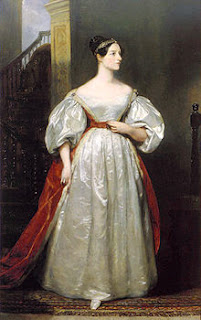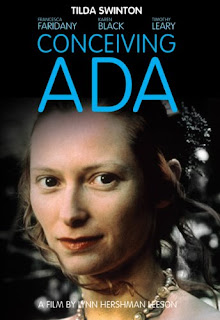 |
| portrait of Ada Lovelace |
In honor of the day, I watched the only movie I could find about her (or featuring her):
Conceiving Ada.
Before I talk about the movie, first some basic information on Ada Lovelace Day, founded to celebrate Augusta Ada Byron King, Countess of Lovelace (AKA Ada Lovelace).
Who is Ada Lovelace?
She is often called the “World’s First Computer Programmer,” although she lived nearly 100 years before the first computer was built. Here is an excerpt from the
Wikipedia page about her:
In 1842 Charles Babbage was invited to give a seminar at the University of Turin about his analytical engine. Luigi Menabrea, a young Italian engineer, and future prime minister of Italy, wrote up Babbage’s lecture in French, and this transcript was subsequently published in the Bibliothèque Universelle de Genève in October 1842.
Babbage asked the Countess of Lovelace to translate Menabrea’s paper into English, subsequently requesting that she augment the notes she had added to the translation. Lady Lovelace spent most of a year doing this. These notes, which are more extensive than Menabrea’s paper, were then published in The Ladies’ Diary and Taylor’s Scientific Memoirs under the initialism “AAL”.
In 1953, over one hundred years after her death, Lady Lovelace’s notes on Babbage’s Analytical Engine were republished. The engine has now been recognised as an early model for a computer and Lady Lovelace’s notes as a description of a computer and software.[27]
Her notes were labelled alphabetically from A to G. In note G, the Countess describes an algorithm for the analytical engine to compute Bernoulli numbers. It is considered the first algorithm ever specifically tailored for implementation on a computer, and for this reason she is often cited in to be the first computer programmer.[28] However the engine was never actually constructed to completion during Lovelace’s lifetime.
The computer language Ada, created on behalf of the United States Department of Defense, was named after Lovelace. The reference manual for the language was approved on 10 December 1980, and the Department of Defense Military Standard for the language, “MIL-STD-1815”, was given the number of the year of her birth. Since 1998, the British Computer Society has awarded a medal in her name[29] and in 2008 initiated an annual competition for women students of computer science.[30]
Ada Lovelace Day has been founded to commemorate her historic place in computing history, and to celebrate women in mathematics, science, engineering, and technology. You can learn more about Ada Lovelace and the project Ada Lovelace Day at the website Finding Ada.
Now, on to the movie!
 |
| Conceiving Ada (1997) |
I debated even watching Conceiving Ada last night after reading reviews, some of which included the words “ridiculous” and “loony.” But, I figure so many woman-centered, woman-directed, and woman-written movies encounter much harsher criticism (especially an overtly feminist movie such as this), and the movie deserved a chance. Plus, it stars Tilda Swinton, for whom I have a borderline-unhealthy obsession, and was written and directed by Lynn Hershman Leeson, whose most recent film was
!Women Art Revolution (which I just mentioned in a post yesterday, oddly enough).
The basic premise of the movie is that a genius DNA researcher Emmy Coer is developing a computer program that will allow her to travel back in time (not physically–just through the computer) to meet and communicate with her muse, 19th century math whiz Ada Byron King. There are troubles along the way to reaching her goal, and consequences to making contact that I don’t entirely understand. And, for some reason, there’s a lot of sex. A lot. Even Victorian-era sex.
I’ll just put the criticisms I have out front, and then get into why the movie is ultimately worth watching. Some of the acting is cringe-worthy, particularly that of main character Emmy’s (Francesca Faridany) boyfriend, and her OB-GYN. There are real moments in the movie that deserve the
MST3K treatment, and one can’t help but joke that the movie’s vision of time travel via computer seems a whole lot like watching a movie (until the women actually communicate with one another). I’ll even admit to a fleeting comparison to
The Room at a particularly awkward moment.
That said, this isn’t one of those “it’s so bad don’t even bother” movies. It’s actually a really interesting one that explores the bonds that did–and do–define female sexuality (even if we do see some unnecessary nudity), in Lovelace’s time and today. It explores motherhood, and the ways that having children both can empower and inhibit women. Finally, it’s a look at women in the field of technological science, and how maybe not a lot has changed since the 19th century.
Of course, the technology portrayed in the movie seems primitive after about 15 years, and the ability to time travel online to talk with long-dead historical figures is a fantasy. The movie was very carefully filmed, and Leeson claims that
“Every scene was structured and shot using a DNA image as a model for actors’ placement andcamera movement.” The movie itself sits firmly in the science fiction/fantasy genre, and if you accept this and focus on what the movie is actually trying to say about memory, women in technology, and DNA, I think you’ll find it quite fascinating and challenging. I did.
Watch the trailer:


